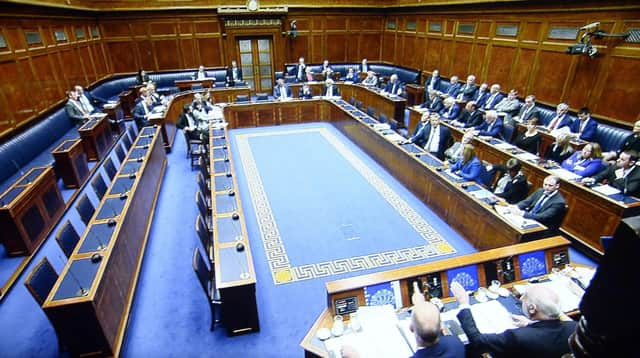Dr Paul Kingsley: Applying the Stormont Brake on EU legislation faces enormous difficulties


You get 30 MLAs to sign a paper. You then hand it to the Secretary of State and he or she puts a block on things. What could be simpler?
In the real world things are more complicated and, in this car, it will be very difficult to brake.
Advertisement
Hide AdAdvertisement
Hide AdFirst, the technical stuff. The Windsor Framework, including the Stormont Brake, was approved by the UK-EU Joint Committee last year under Article 164 of the Withdrawal Agreement (Decision 1/2023). This particular article said that changes could be made to the protocol “provided that such decisions may not amend the essential elements of this Agreement” (par.5(d)).
When you agree to play by the EU rules, you can only tinker. The changes relating to the Brake became part of Article 13(3a) of the Windsor Framework, and this article was incorporated into British law as the Windsor Framework (Democratic Scrutiny) Regulations 2024. Those regulations in turn became Schedule 6B of the Northern Ireland Act 1998, which, back in the day, gave legal force to the Belfast Agreement.
These lawyers certainly like to complicate things, don’t they?
So, we have got our 30 signatures objecting to some replacement or amended EU law and we have handed the document (the notification) to the Secretary of State. What happens then?
Advertisement
Hide AdAdvertisement
Hide AdHe or she must check if a number of conditions are met. Last year, when the joint committee made its decision 1/2023, it allowed the British government to append a unilateral declaration to the document, setting out how the Brake would work.
Don’t be misled by the term “unilateral”. The declaration had the wholehearted approval of the European Commission. That unilateral declaration, also referred to in the legislation as the Article 13(3a) Declaration, means that the Secretary of State has to check that “the notification is only being made in the most exceptional circumstances and as a last resort, having used every other available mechanism”.
The Brake cannot therefore be used to routinely object to EU legislation.
He or she also has to consider whether the changes objected to by the 30 MLAs “would have a significant impact specific to everyday life of communities in Northern Ireland in a way that is liable to persist.”
Advertisement
Hide AdAdvertisement
Hide AdNow, in deciding such things, the Secretary of State may take account of the views of the Windsor Framework Democratic Scrutiny Committee. This is made up of nine MLAs and has a pro-protocol/Windsor Framework majority. It can set up an inquiry into a piece of legislation which is being replaced or amended, and the committee can produce a report.
How does the work of the committee relate to the 30 MLAs’ notification? The Northern Ireland Office produced an explanatory memorandum which was laid before Parliament last year, and this provides the answer.
“It is anticipated that any use of the Brake would ordinarily follow the committee’s work, where it does decide to conduct an inquiry, rather than pre-empting it.”
Thus, the scrutiny committee could produce a report by majority decision which says, in effect: “There is absolutely no problem with this legislation”.
Advertisement
Hide AdAdvertisement
Hide AdOnly when this report is available will the 30 MLAs’ Stormont Brake notification be considered. This would make it difficult for the Secretary of State to support the objectors.
Suppose that, against all the odds, the British government backs the 30 MLAs and decides some EU legislation should be blocked. That is not the end of the matter. The EU could object and refer the matter to arbitration.
Back in 2020, the EU and the UK each proposed the names of 10 potential arbitration panel members, and jointly proposed the names of five potential chairs. These were typically lawyers and academics.
A panel would consist of a chair plus two nominees from each side. It may well take account of a pro-Protocol/Windsor Framework report produced by the scrutiny committee.
Advertisement
Hide AdAdvertisement
Hide AdIn addition to reviewing the matters considered by the Secretary of State, the panel will decide whether the application has been made in compliance with Article 5 of the Withdrawal Agreement (as per the joint declaration of the UK- EU Joint Committee). This introduces the concept of “good faith”.
The UK government “shall take all appropriate measures, whether general or particular, to ensure fulfilment of the obligations arising from this agreement and shall refrain from any measures which could jeopardise the attainment of the objectives of this agreement.”
In other words, the Stormont Brake cannot be used to frustrate the aims of the Northern Ireland Protocol/Windsor Framework, which is an integral part of the Withdrawal Agreement. The British government must show its loyalty to the process.
The panel may take the view that this involves an interpretation of EU law. A European Commission press release, issued when the Windsor Framework was agreed, said “The Court of Justice of the European Union remains the sole and ultimate arbiter of EU law.”
Advertisement
Hide AdAdvertisement
Hide AdThe panel could refer a point of EU law to the European Court of Justice, and its ruling would be binding.
Applying the Stormont Brake faces huge difficulties. Are you feeling lucky?
Dr Paul Kingsley is a retired academic and active researcher